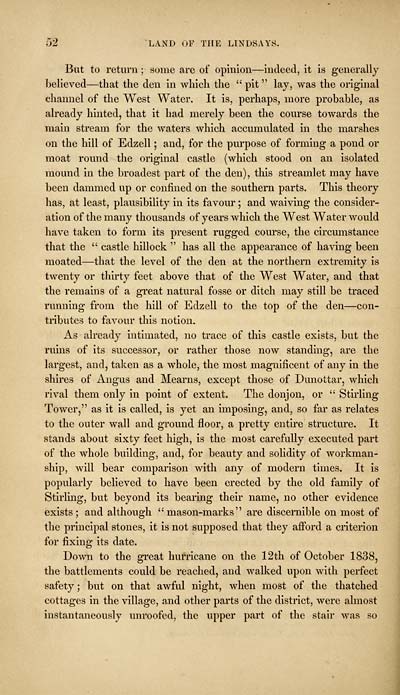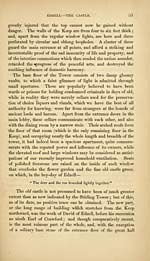Download files
Complete book:
Individual page:
Thumbnail gallery: Grid view | List view

52 LAND OF THE LINDSAYS.
But to return ; some are of opinion — indeed, it is generally
believed — that the den in which the " pit " lay, was the original
channel of the West Water. It is, perhaps, more probable, as
already hinted, that it had merely been the course towards the
main stream for the waters which accumulated in the marshes
on the hill of Edzell ; and, for the purpose of forming a pond or
moat round the original castle (which stood on an isolated
mound in the broadest part of the den), this streamlet may have
been dammed up or confined on the southern parts. This theory
has, at least, plausibility in its favour ; and waiving the consider-
ation of the many thousands of years which the West Water would
have taken to form its present rugged course, the circumstance
that the " castle hillock " has all the appearance of having been
moated — that the level of the den at the northern extremity is
twenty or thirty feet above that of the West Water, and that
the remains of a great natural fosse or ditch may still be traced
running from the hill of Edzell to the top of the den — con-
tributes to favour this notion.
As already intimated, no trace of this castle exists, but the
ruins of its successor, or rather those now standing, are the
largest, and, taken as a whole, the most magnificent of any in the
shires of Angus and Mearns, except those of Dunottar, which
rival them only in point of extent. The donjon, or " Stirling
Tower," as it is called, is yet an imposing, and, so far as relates
to the outer wall and ground floor, a pretty entire structure. It
stands about sixty feet high, is the most carefully executed part
of the whole building, and, for beauty and solidity of workman-
ship, will bear comparison with any of modern times. It is
popularly believed to have been erected by the old family of
Stirling, but beyond its bearing their name, no other evidence
exists; and although "mason-marks" are discernible on most of
the principal stones, it is not supposed that they afford a criterion
for fixing its date.
Down to the great hurricane on the 12th of October 1838,
the battlements could be reached, and walked upon with perfect
safety ; but on that awful night, when most of the thatched
cottages in the village, and other parts of the district, were almost
instantaneously unroofed, the upper part of the stair was so
But to return ; some are of opinion — indeed, it is generally
believed — that the den in which the " pit " lay, was the original
channel of the West Water. It is, perhaps, more probable, as
already hinted, that it had merely been the course towards the
main stream for the waters which accumulated in the marshes
on the hill of Edzell ; and, for the purpose of forming a pond or
moat round the original castle (which stood on an isolated
mound in the broadest part of the den), this streamlet may have
been dammed up or confined on the southern parts. This theory
has, at least, plausibility in its favour ; and waiving the consider-
ation of the many thousands of years which the West Water would
have taken to form its present rugged course, the circumstance
that the " castle hillock " has all the appearance of having been
moated — that the level of the den at the northern extremity is
twenty or thirty feet above that of the West Water, and that
the remains of a great natural fosse or ditch may still be traced
running from the hill of Edzell to the top of the den — con-
tributes to favour this notion.
As already intimated, no trace of this castle exists, but the
ruins of its successor, or rather those now standing, are the
largest, and, taken as a whole, the most magnificent of any in the
shires of Angus and Mearns, except those of Dunottar, which
rival them only in point of extent. The donjon, or " Stirling
Tower," as it is called, is yet an imposing, and, so far as relates
to the outer wall and ground floor, a pretty entire structure. It
stands about sixty feet high, is the most carefully executed part
of the whole building, and, for beauty and solidity of workman-
ship, will bear comparison with any of modern times. It is
popularly believed to have been erected by the old family of
Stirling, but beyond its bearing their name, no other evidence
exists; and although "mason-marks" are discernible on most of
the principal stones, it is not supposed that they afford a criterion
for fixing its date.
Down to the great hurricane on the 12th of October 1838,
the battlements could be reached, and walked upon with perfect
safety ; but on that awful night, when most of the thatched
cottages in the village, and other parts of the district, were almost
instantaneously unroofed, the upper part of the stair was so
Set display mode to:
![]() Universal Viewer |
Universal Viewer | ![]() Mirador |
Large image | Transcription
Mirador |
Large image | Transcription
Images and transcriptions on this page, including medium image downloads, may be used under the Creative Commons Attribution 4.0 International Licence unless otherwise stated. ![]()
| Histories of Scottish families > History and traditions of the land of the Lindsays in Angus and Mearns > (70) Page 52 |
|---|
| Permanent URL | https://digital.nls.uk/94869866 |
|---|
| Description | A selection of almost 400 printed items relating to the history of Scottish families, mostly dating from the 19th and early 20th centuries. Includes memoirs, genealogies and clan histories, with a few produced by emigrant families. The earliest family history goes back to AD 916. |
|---|

